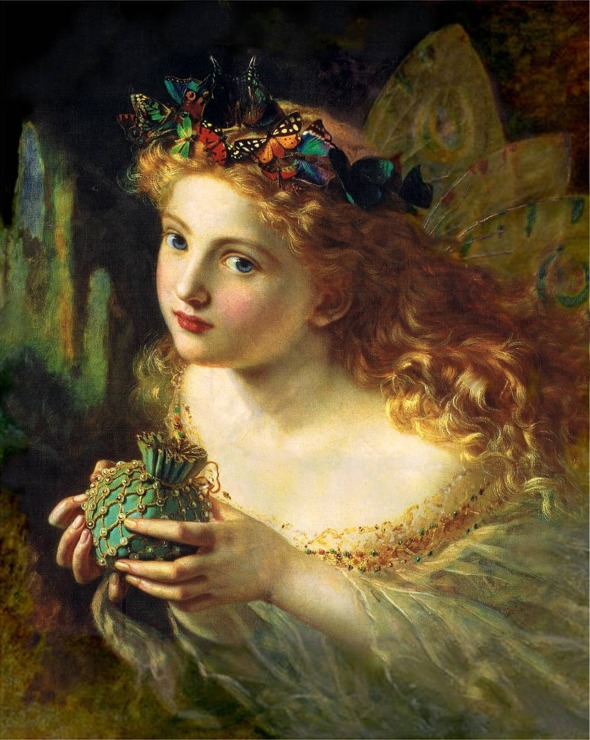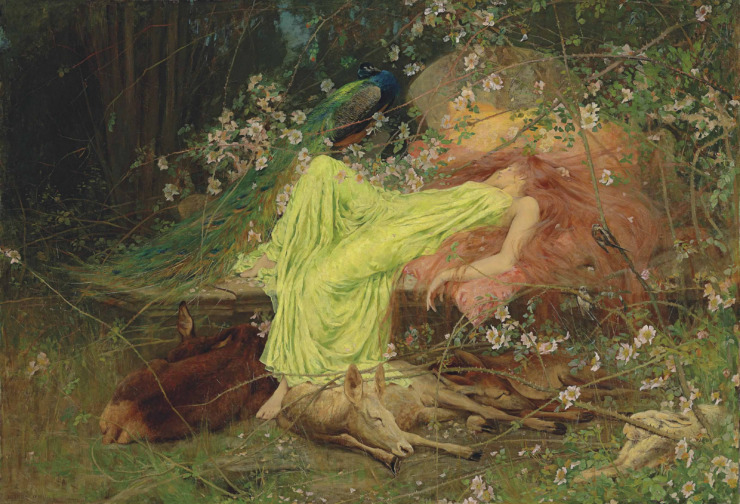Faery Songs
I.
Shed no tear! oh, shed no tear!
The flower will bloom another year.
Weep no more! oh, weep no more!
Young buds sleep in the root’s white core.
Dry your eyes! oh, dry your eyes!
For I was taught in Paradise
To ease my breast of melodies,–
Shed no tear.
Overhead! look overhead!
‘Mong the blossoms white and red–
Look up, look up! I flutter now
On this fresh pomegranate bough.
See me! ’tis this silvery bill
Ever cures the good man’s ill.
Shed no tear! oh, shed no tear!
The flower will bloom another year.
Adieu, adieu — I fly — adieu!
I vanish in the heaven’s blue,–
Adieu, adieu!
II.
Ah! woe is me! poor silver-wing!
That I must chant thy lady’s dirge,
And death to this fair haunt of spring,
Of melody, and streams of flowery verge,–
Poor silver-wing! ah! woe is me!
That I must see
These blossoms snow upon thy lady’s pall!
Go, pretty page! and in her ear
Whisper that the hour is near!
Softly tell her not to fear
Such calm favonian burial!
Go, pretty page! and soothly tell,–
The blossoms hang by a melting spell,
And fall they must, ere a star wink thrice
Upon her closed eyes,
That now in vain are weeping their last tears,
At sweet life leaving, and these arbours green,–
Rich dowry from the Spirit of the Spheres,
Alas! poor Queen!
-John Keats
Enjoy Artistic Representations of “Faery Songs” by John Keats

Take the Fair Face of Woman, and Gently Suspending, With Butterflies, Flowers, and Jewels Attending, Thus Your Fairy is Made of Most Beautiful Things by Danielle Gengembre Boás Anderson.

A Fairy Tale by Arthur Wardle.
Listen to this Reading of “Faery Songs”
Listen to Musical Interpretations of “Faery Songs” by John Keats
John Keats Biography
Keats was born in London on Oct. 31, 1795; a few weeks later he was baptized at St. Botolph Without Bishopsgate Church, near where his parents lived and father worked as the manager of a stable owned by his father-in-law. Keats was the eldest of four children, with George, Tom, and Fanny following him. The family was well off enough that the boys were sent to Clark’s Academy in Edmonton at what is now the north London borough of Enfield for their education; it was riding his horse home from a visit to the school that Keats’ father fell and died the next day. His mother remarried (rather quickly, in fact), fought with the rest of the family, and died fairly young from consumption or tuberculosis, which was all too common at the time and would eventually claim the life of Keats’ youngest brother, Tom, as well as Keats himself.
He was apprenticed to a local doctor, but the relationship didn’t seem to work too well. He ended up working at St. Guy’s Hospital in the Southwark district of London, continuing his medical training and writing poetry (the site of the original St. Guy’s in now occupied by London’s tallest office building, known locally as “The Shard”).
While Keats had numerous city connections (Anita Miller also has a “Keats in the City” walk), it is with Hampstead that he is most closely associated. Fellow poets lived there, as did the editor who first published his poetry. Artists whom Keats associated with lived there. Keats himself would move there with his brothers. Keats and his friends would wander Hampstead Heath, talking and arguing poetry and the issues of the day. After moving into Wentworth House in Hampstead, Keats wrote five of six famous odes, including “Ode to a Nightingale.” And it would be at Wentworth House in Hampstead that Keats would realize that he was dying from the same disease that took his mother and younger brother.
Enjoyed Faery Songs by John Keats and want to know more about Keats’ life? Try A Month With Keats: A Walk Into His Life
That’s it for Faery Song!
BUY ‘HOW TO WRITE A FORM POEM’ NOW!
